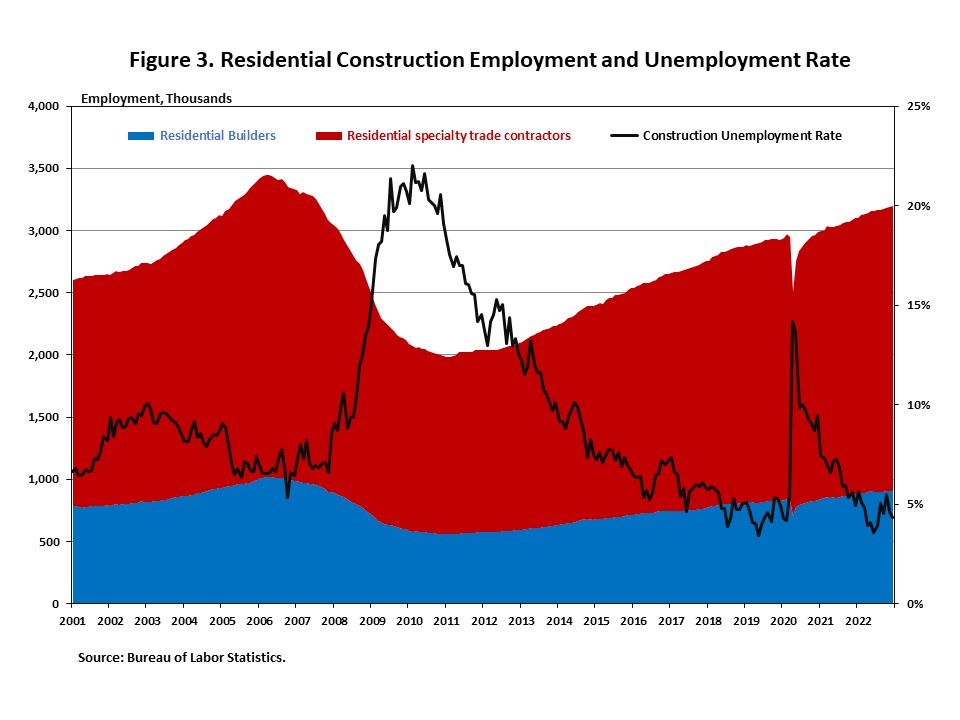Job growth slowed in recent months, but the overall labor market remains tight. In December, total nonfarm payroll employment increased by 223,000, and the unemployment rate ticked down to 3.5%, back to its lowest point before the pandemic. However, in a positive sign for inflation, wage growth slowed to a 4.6% year-over-year gain, the slowest pace since August 2021.
Construction industry employment (both residential and non-residential) totaled 7.8 million and exceeds its February 2020 level. Residential construction gained 9,500 jobs, while non-residential construction employment gained 17,900 jobs in December. Residential construction employment exceeds its level in February 2020, while 89% of non-residential construction jobs lost in March and April 2020 have now been recovered.

Total nonfarm payroll employment increased by 223,000 in December, following a gain of 256,000 in November, as reported in the Employment Situation Summary. It marks the smallest monthly job gain since December 2019 (excluding three losses in 2020). Monthly employment growth has been falling for the past five consecutive months. The estimates for the previous two months were revised. The estimate for October was revised down by 21,000 from +284,000 to +263,000, while the November increase was revised down by 7,000, from +263,000 to +256,000.
Despite the tight monetary policy, over 4.5 million jobs have been created in the past twelve months of 2022 as the economy continued to recover from the 2020 shutdown. Monthly employment growth averaged 375,000 per month in 2022, less than a 562,000 monthly average gain in 2021, but doubled the monthly average gain of 164,000 in 2019, the year before the Covid pandemic.
The unemployment rate edged down to 3.5% in December, as the number of unemployed persons decreased to 5.7 million and the number of employed persons increased by 717,000.
Meanwhile, the labor force participation rate, the proportion of the population either looking for a job or already with a job, edged up 0.1 percentage point to 62.3% in December, reflecting the increase in the number of persons in the labor force (+439,000) and the decrease in the number of persons not in the labor force (-303,000). Moreover, the labor force participation rate for people who aged between 25 and 54 ticked up to 82.4%, after three months of decreases. Both of these two rates are still below their pre-pandemic levels at the beginning of 2020 and are not fully recovered from the COVID-19 pandemic.

For industry sectors, leisure and hospitality (+67,000), health care (+55,000), and construction (+28,000) had notable job gains in December, while employment in retail trade (+9,000), manufacturing (+8,000), transportation and warehousing (+5,000) and government (+3,000) changed little.
Employment in the overall construction sector rose by 28,000 in December, following a 15,000 gain in November. Residential construction gained 9,500 jobs, while non-residential construction employment gained 17,900 jobs in December.
Residential construction employment now stands at 3.2 million in December, broken down as 909,000 builders and 2.3 million residential specialty trade contractors. The 6-month moving average of job gains for residential construction was 6,717 a month. Over the last 12 months, home builders and remodelers added 98,300 jobs on a net basis. Since the low point following the Great Recession, residential construction has gained 1,213,200 positions.
In December, the unemployment rate for construction workers declined by 0.3 percentage points to 4.3% on a seasonally adjusted basis. The unemployment rate for construction workers has been trending lower, after reaching 14.2% in April 2020, due to the housing demand impact of the COVID-19 pandemic.

Discover more from Eye On Housing
Subscribe to get the latest posts sent to your email.
